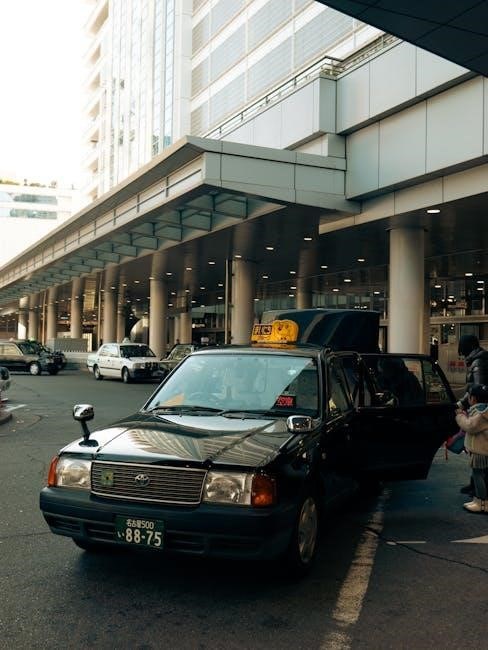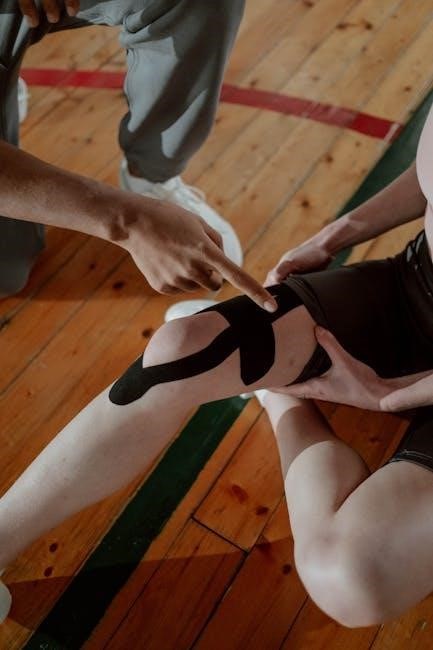Tools and Materials Needed
To remove the bed from your 2001 Toyota Tundra Access Cab, you’ll need a 55 Torx socket, ratchet, and extension for the bolts. A hydraulic jack and 4 jack stands or blocks are essential for lifting. A utility knife or pry bar may be needed for the bedliner. Penetrating oil like WD-40 can help loosen stuck bolts. Gloves and safety glasses are recommended for protection. A furniture dolly or hoist can assist in moving the bed once removed.

Preparation
Before removing the bed from your 2001 Toyota Tundra Access Cab, thorough preparation is essential to ensure a smooth and safe process. Start by gathering all the necessary tools and materials, such as a 55 Torx socket, ratchet, extension, hydraulic jack, and jack stands. Protect your workspace by covering the ground and surrounding areas with drop cloths or old sheets to prevent damage from falling tools or debris.
Next, remove any personal items or accessories from the bed, including the bedliner, tie-downs, and cargo management systems. If the bedliner is stuck, use a utility knife or pry bar to carefully loosen and remove it. This step is crucial to access the bolts securing the bed to the frame. Soak the bolts with penetrating oil, such as WD-40, to loosen any rust or corrosion, making them easier to remove later.
Disconnect the fuel tank skid plate to access the bolts near the fuel filler neck. This step may require additional tools, such as a wrench or socket set. Drain the fuel tank or siphon as much fuel as possible to reduce weight and prevent spills during the removal process. If you’re unsure about how to drain the tank safely, consult a professional mechanic or refer to your owner’s manual.
Position the truck on level ground and engage the parking brake. Place jack stands under the frame near the cab to stabilize the vehicle and prevent it from shifting during the removal. Wear protective gear, such as gloves and safety glasses, to safeguard yourself from potential hazards like falling tools or sharp edges.
Finally, inspect the area around the bed for any obstructions, such as wiring or hoses, and secure them with tape or zip ties to avoid damage. Take photos or notes of the bolt locations and wiring connections to ensure everything is reinstalled correctly later. By following these preparation steps, you’ll be well-prepared to safely and efficiently remove the bed from your 2001 Toyota Tundra Access Cab.
Removing the Bed
Removing the bed from your 2001 Toyota Tundra Access Cab requires careful execution to avoid damage or injury. Start by removing the bedliner, which may be secured with bolts or adhesive. Use a utility knife or pry bar to gently pry it loose if it’s stuck. Once the bedliner is removed, you’ll have access to the bolts that secure the bed to the frame.
Locate the six bolts under the bed and the four additional bolts around the fuel filler neck. Use a 55 Torx socket and ratchet to remove these bolts. Apply penetrating oil like WD-40 to any rusted or corroded bolts to ease removal. After removing all bolts, the bed will be loose but still heavy, requiring careful lifting.
Position a hydraulic jack under the bed and slowly lift it. Use jack stands for added stability and safety. As you lift, maneuver the bed backward to clear the cab. Some people use blocks or makeshift pulleys, like a swing set, to hoist the bed and slide out from underneath. Ensure the bed is secure during this process to prevent accidents.
Once the bed is completely lifted and moved away from the cab, you can remove it entirely. Inspect the area for any remaining bolts or debris and clean up as needed. Remember to handle the bed with care due to its weight and size.
Throughout the removal process, prioritize safety by wearing gloves and safety glasses. Keep children and pets away, and consider enlisting help or using a furniture dolly for better control. By following these steps methodically, you can successfully remove the bed from your 2001 Toyota Tundra Access Cab.

Draining the Fuel Tank
Draining the fuel tank is a crucial step before removing the bed from your 2001 Toyota Tundra Access Cab. This process ensures safety and prevents any fuel spills or leaks during the removal process. Start by disconnecting the negative terminal of your battery to prevent any accidental ignition sources. Next, locate the fuel tank, which is situated underneath the truck, near the rear axle. Use a fuel drain kit or a siphon hose to safely remove the fuel from the tank.
Before draining, make sure the truck is on level ground and apply the parking brake. If the fuel tank is nearly full, consider transferring the fuel to a gas can or another vehicle using a proper fuel transfer pump. Avoid using makeshift or unsafe methods, as this could lead to contamination or spills. If you’re uncomfortable draining the tank yourself, consult a professional mechanic or a local service station for assistance.
Once the tank is empty, disconnect the fuel lines from the tank to the engine. Use a wrench or pliers to release the fuel line fittings, and cap the lines to prevent dirt or debris from entering the fuel system. Inspect the area around the tank for any leaks or damage before proceeding with the bed removal. Draining the fuel tank is a straightforward process but requires attention to detail to ensure safety and avoid potential hazards.
Remember to dispose of the drained fuel responsibly, as improper disposal can harm the environment. Always follow local regulations for hazardous waste disposal. By draining the fuel tank, you’ll minimize risks and create a safer working environment for removing the bed.
After completing this step, you’ll be ready to move on to lifting and removing the bed. Keep in mind that the fuel tank area should remain clear of tools and debris to prevent accidental damage. If you encounter any issues during the draining process, stop immediately and seek professional help.

Lifting the Bed
Lifting the bed of your 2001 Toyota Tundra Access Cab is a critical step in the removal process. Before you begin, ensure the truck is on level ground and the parking brake is engaged. Use a hydraulic jack or a lift to elevate the bed, but always support it with jack stands for safety. Position the jack under the bed’s frame near the bolts you removed earlier, ensuring it is stable and even.
Start by lifting the bed slightly to check for any remaining connections, such as wiring harnesses or fuel lines, which may still be attached. If you encounter resistance, double-check that all bolts and fasteners have been removed. Once clear, continue lifting until the bed is high enough to access the area beneath it. Have at least one person assist you to ensure the bed remains balanced and secure.
For additional support, place wooden blocks or jack stands under the bed’s edges to prevent it from shifting or falling. If you’re using a hoist or pulley system, ensure it is rated for the weight of the bed and securely attached. Be cautious of the gas filler neck, as it curves under the cab and may require careful maneuvering to avoid damage.
After lifting, inspect the bed for any remaining attachments or obstructions. Use a dolly or furniture slider to move the bed away from the truck if needed. Always maintain control of the bed during the lifting process, as it can be heavy and unpredictable. If you’re unsure about any step, consider consulting a professional or enlisting additional help.
Remember to lower the bed slowly and carefully if you need to reposition it. Never leave the bed unsupported, as it could fall and cause injury or damage. Once the bed is lifted and secure, you’ll have clear access to the truck’s frame and other components for further work or inspection.
Lifting the bed is a challenging but manageable task with the right tools and precautions. Stay focused and take your time to ensure a safe and successful removal process.

Post-Removal
Once the bed is successfully removed from your 2001 Toyota Tundra Access Cab, it’s important to take a few steps to ensure everything is secure and prepared for the next phase of your project. First, inspect the area where the bed was mounted for any debris, rust, or damage. Clean the frame thoroughly to remove dirt, old adhesive, or remaining bedliner material. This will ensure a smooth surface for reinstallation or further modifications.
Next, check all electrical connections, fuel lines, and wiring harnesses that were previously connected to the bed. Make sure they are secure and not damaged during the removal process. If any components were disconnected, now is the time to reconnect them or label them for future reference. Inspect the gas filler neck and surrounding areas to ensure they are undamaged and properly aligned.
If you plan to reinstall the bed or replace it with a new one, use this opportunity to prepare the mounting points. Apply a rust-inhibiting coating to the frame to protect it from corrosion. Additionally, inspect the bed bolts and mounting hardware for wear or damage. Replace any compromised components to ensure a secure and proper fit when the bed is reinstalled.
If you’re not immediately replacing the bed, consider storing it in a dry, protected area to prevent damage. Cover the bed with a tarp or protective covering to shield it from the elements. For long-term storage, ensure the bed is elevated off the ground to avoid moisture accumulation and rust formation.
Finally, take a moment to review the removal process and ensure all steps were completed safely and correctly. Double-check that the truck is stable and secure before moving on to the next phase of your project. Whether you’re replacing the bed or performing further modifications, proper post-removal care will ensure a successful outcome.
Replacing the Bed
Replacing the bed on your 2001 Toyota Tundra Access Cab is the final step after removal. Start by ensuring the new or repaired bed is clean, dry, and free of debris. If using a replacement bed, verify that it is compatible with your truck’s make and model. Align the bed with the truck’s frame, ensuring the mounting points match up perfectly. This step requires precision to avoid misalignment, which could lead to improper fitment or damage.
Once the bed is properly positioned, use the 55 Torx socket to reinstall the mounting bolts. Tighten the bolts in a star pattern to ensure even pressure and prevent warping of the bed or frame. Be careful not to overtighten, as this could damage the threads or the bed itself. If the bed is new, apply a small amount of penetrating oil to the bolts to ensure they seat properly and to prevent rust over time.
Reconnect any electrical components, such as wiring harnesses or lights, that were disconnected during the removal process. Check the fuel filler neck to ensure it is securely reattached and properly aligned with the gas tank. If you removed any additional components like the bumper or tailgate, now is the time to reinstall them.
After the bed is securely in place, double-check all bolts and connections to ensure they are tight and functioning correctly. Test the tailgate and any bed-mounted accessories to confirm they work as intended. Finally, inspect the bed and surrounding areas for any gaps or misalignments, making adjustments as needed.
With the bed replaced, your truck is now ready for use. Properly tightening and aligning the bed will ensure a smooth and secure fit, preventing future issues. If you’re unsure about any step, consider consulting a professional mechanic or a detailed repair manual for guidance.

Safety Tips
When removing the bed from your 2001 Toyota Tundra Access Cab, safety should always be your top priority. Start by ensuring the truck is on level ground and in park with the parking brake engaged. Use jack stands to support the truck and bed during the process, as hydraulic jacks can fail under the weight. Never rely solely on a jack to hold the bed or truck in place.
Wear protective gear such as gloves and safety glasses to protect yourself from sharp edges, falling debris, or tools slipping during the process. If you’re working in a garage or enclosed space, ensure proper ventilation to avoid inhaling dust, rust particles, or fumes from penetrating oils or rust inhibitors.
When lifting or moving the bed, use a furniture dolly or hoist to reduce the risk of injury. The bed is heavy, so enlisting the help of at least two additional people is highly recommended. Avoid using makeshift supports or unstable objects to lift or hold the bed, as this could lead to accidents.
Be cautious when handling tools, especially power tools like impact wrenches, which can slip and cause injury. Keep loose clothing and long hair tied back to avoid entanglement with tools or equipment. If you notice any signs of damage or wear on the bed mounting points or bolts, address them immediately to prevent further issues.
After the bed is removed, ensure the truck and bed are stable and secure before starting any repairs or maintenance. Always refer to your owner’s manual or a detailed repair guide for specific instructions tailored to your vehicle. If you’re unsure about any step, consider consulting a professional mechanic to avoid potential risks.
By following these safety tips, you can minimize the risks associated with removing and replacing the bed on your 2001 Toyota Tundra Access Cab. Remember, safety is not just about protecting yourself but also ensuring the integrity of your vehicle for years to come.



